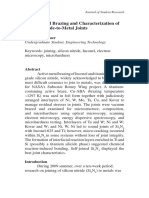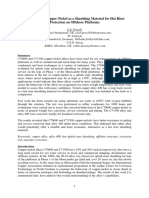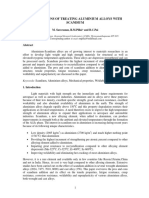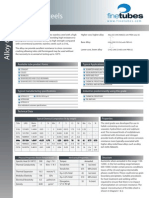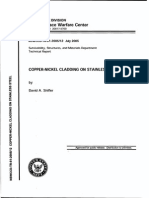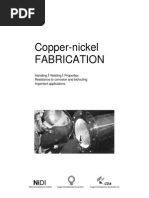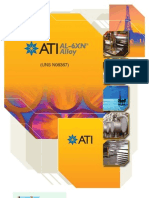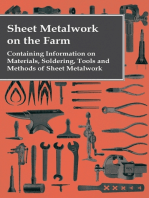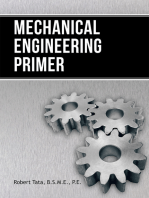Monel K-500: Ni-Cu-Al Incoloy 925: Ni-Fe-Cr
Monel K-500: Ni-Cu-Al Incoloy 925: Ni-Fe-Cr
Uploaded by
esp-metallurgistCopyright:
Available Formats
Monel K-500: Ni-Cu-Al Incoloy 925: Ni-Fe-Cr
Monel K-500: Ni-Cu-Al Incoloy 925: Ni-Fe-Cr
Uploaded by
esp-metallurgistOriginal Title
Copyright
Available Formats
Share this document
Did you find this document useful?
Is this content inappropriate?
Copyright:
Available Formats
Monel K-500: Ni-Cu-Al Incoloy 925: Ni-Fe-Cr
Monel K-500: Ni-Cu-Al Incoloy 925: Ni-Fe-Cr
Uploaded by
esp-metallurgistCopyright:
Available Formats
INCOLOY 925 Versus Monel K-500
June 2010 1. Chemical composition
Monel K-500: Ni-Cu-Al
Incoloy 925: Ni-Fe-Cr
2. Corrosion Resistance
3. Mechanical property
4. Machinability Alloy 925 is easier to machine than alloy 718. The graph compares the machinability of alloys 718 and 925 with INCOLOY alloy 945. The data is generated using un-coated carbide tooling. Alloy 718 data is obtained from the literature.
70
60
50
Tool Life-Minutes
40
30 945 I-718 20 925
10
0 50 100 150 200 250 Speed-SFPM 300 350 400 450
5. Comparison of the 925 0.885 bar with Monel K-500 Shaft Yield ksi Monel K-500 100 MIN strength, Tensile strength, Elongation, ksi 140 - 212 % Hardness, HRC 25 41
K-500
bar,
Hot-worked+ 100 MIN
140 MIN
20 MIN
27 MIN
age-hardened - ASTM B865 K-500 bar, Cold-worked+ 110 MIN 145 MIN 15 MIN 32 MIN
age-hardened - ASTM B865 K-500 0.875 bar, cold 145.8 drawn + age hardened K-500 0.890 bar, cold 143.7 drawn + age hardened 925 0.885 bar 170 193 19 41 174.5 19.1 35.1 177.7 26 38
6. Summary Incoloy 925 (44Ni-28Fe-21Cr-3Mo-1.8Cu) alloy has been compared with Monel K-500 (65Ni30Cu-3Al) alloy in terms of chemical composition, corrosion resistance, and mechanical property. Both alloys have an excellent corrosion resistance in most of corrosive environments. Both alloys are immune to chloride stress cracking. However, there is a higher crevice depth of Incoloy 925 than that of Monel K-500 in seawater (the presence of chloride, sulfate, bicarbonate, dissolved oxygen, etc.) at ambient temperature. There is no crevice attack on Incoloy 925 alloy if there is only 3.5% sodium chloride in a solution at ambient temperature. Machinability of Incoloy 925 alloy is better than that of Inconel 718 alloy. The proposed Incoloy 925 alloy bar possesses the mechanical property confirming to the mechanical requirements of Monel K-500 shaft in ASTM standard. The proposed Incoloy 925 alloy shaft has the higher yield/tensile strength and hardness than the current Monel K-500 shaft, however, it has a slightly lower elongation than the current Monel K-500 shaft.
You might also like
- Technical Update Welding of Nickel Nikel AlloysDocument15 pagesTechnical Update Welding of Nickel Nikel Alloysreza100% (1)
- Copper Nickel - Splash Zone Sheathing of Oil-Gas PlatformsDocument11 pagesCopper Nickel - Splash Zone Sheathing of Oil-Gas Platformsbello imamNo ratings yet
- CuniDocument32 pagesCunikampit100% (1)
- Copper Nickel Alloy 7030 E28093 UNS C71500 E28093 CupronickelDocument6 pagesCopper Nickel Alloy 7030 E28093 UNS C71500 E28093 CupronickelSantosh TiwariNo ratings yet
- 11 CR-CB Data SheetDocument2 pages11 CR-CB Data SheetJLZ972No ratings yet
- Examination of The Effect of SC On 2000 and 7000 Series Aluminium Alloy Castings: For Improvements in Fusion WeldingDocument11 pagesExamination of The Effect of SC On 2000 and 7000 Series Aluminium Alloy Castings: For Improvements in Fusion WeldingsubNo ratings yet
- Reinforced Aluminum PDFDocument5 pagesReinforced Aluminum PDFsmani170No ratings yet
- Pub 139 Copper Nickel Welding and Fabrication PDFDocument32 pagesPub 139 Copper Nickel Welding and Fabrication PDFG.SWAMI100% (1)
- Active Metal BrazingDocument14 pagesActive Metal BrazingAngel Leon GeronimoNo ratings yet
- Ni Inco 515 Somenickel Coppercastingalloys EngineeringpropertiesDocument11 pagesNi Inco 515 Somenickel Coppercastingalloys EngineeringpropertiesAjeeth KumarNo ratings yet
- Monel Sheathing Technial PaperDocument15 pagesMonel Sheathing Technial Paperharan2000No ratings yet
- Austral Wright Metals: CuttingDocument10 pagesAustral Wright Metals: CuttingScribdSnake123100% (1)
- The Rotating Cylinder Electrode PDFDocument11 pagesThe Rotating Cylinder Electrode PDFbuvanseaNo ratings yet
- 2006 Al SC Alu IndiaDocument12 pages2006 Al SC Alu Indiamsaravanan04No ratings yet
- Niobium Microalloyed Cold Heading Steel Wire Rods Without Heat Treatment For Fastener ApplicationsDocument7 pagesNiobium Microalloyed Cold Heading Steel Wire Rods Without Heat Treatment For Fastener Applicationsnvc_vishwanathanNo ratings yet
- Splash Zone Michels PowellDocument18 pagesSplash Zone Michels PowellMohammed Shareef ShaikhNo ratings yet
- Application of Cu-Ni Alloys For Sea Water ServicesDocument14 pagesApplication of Cu-Ni Alloys For Sea Water ServiceskarunaNo ratings yet
- Monel Alloy K-500Document20 pagesMonel Alloy K-500wholenumberNo ratings yet
- Automotive PDFDocument24 pagesAutomotive PDFbathinsreenivasNo ratings yet
- Alloy 6moDocument2 pagesAlloy 6moqshaath100% (1)
- Inconel 625Document3 pagesInconel 625alokbdasNo ratings yet
- Carderock - CUNI Cladding of StainlessDocument36 pagesCarderock - CUNI Cladding of StainlessdhlinvaNo ratings yet
- PTC Creo GearDocument6 pagesPTC Creo Gearbrpnaidu2157No ratings yet
- Nickel Added To Aluminoum Bronze AlloyDocument11 pagesNickel Added To Aluminoum Bronze AlloyOrnella MancinelliNo ratings yet
- Superduplex Stainless Steel Article-4Document3 pagesSuperduplex Stainless Steel Article-4mengelito almonteNo ratings yet
- Full Reportholo KuloDocument60 pagesFull Reportholo KuloRohit SharmaNo ratings yet
- Inconel Alloy MA754Document8 pagesInconel Alloy MA754Sai KartheekNo ratings yet
- High-Performance Alloys For Gas TurbinesDocument19 pagesHigh-Performance Alloys For Gas Turbineskoohestani_afshinNo ratings yet
- EngineeringWithCladSteel2ndEd PDFDocument24 pagesEngineeringWithCladSteel2ndEd PDFUNIISCRIBDNo ratings yet
- Sintering Stainless SteelDocument42 pagesSintering Stainless SteelSteve GreenNo ratings yet
- Copper AlloysDocument4 pagesCopper AlloysBookMaggotNo ratings yet
- INCONEL 686 - INCO-WELD 686CPT Application List For IndiaDocument10 pagesINCONEL 686 - INCO-WELD 686CPT Application List For IndiaBhanu Pratap ChoudhuryNo ratings yet
- Alloys For Gas TurbinesDocument18 pagesAlloys For Gas TurbineszuudeeNo ratings yet
- ValveWorld06 P0607 Strang-Valve Materials For Seawater NAB RivalsDocument18 pagesValveWorld06 P0607 Strang-Valve Materials For Seawater NAB RivalsYQNo ratings yet
- Final ThesisDocument60 pagesFinal ThesisManjunatha EikilaNo ratings yet
- Mechanical and Wear Properties of Sic/Graphite Reinforced Al359 Alloy-Based Metal Matrix CompositeDocument9 pagesMechanical and Wear Properties of Sic/Graphite Reinforced Al359 Alloy-Based Metal Matrix CompositeKiru CherryNo ratings yet
- A New Zinc Alloy Ilzro 12Document9 pagesA New Zinc Alloy Ilzro 12uzairmetallurgistNo ratings yet
- Copper Nickel FabricationDocument28 pagesCopper Nickel Fabricationgrtuna100% (1)
- C 61400Document2 pagesC 61400ghetto_bmx_boyNo ratings yet
- Aisi 1040 Carbon Steel (Uns g10400)Document3 pagesAisi 1040 Carbon Steel (Uns g10400)anishraobNo ratings yet
- Aluminum Alloy Drill PipeDocument20 pagesAluminum Alloy Drill PipeMark Garrett100% (1)
- AL-6XN SourcebookDocument59 pagesAL-6XN SourcebooklkrzyzanNo ratings yet
- Tribological Studies and Microstructural Characterisation of Sic and Fly Ash Particles Based Aluminium 2024 Alloy Composites Prepared Through Stir Casting RouteDocument9 pagesTribological Studies and Microstructural Characterisation of Sic and Fly Ash Particles Based Aluminium 2024 Alloy Composites Prepared Through Stir Casting RouteMajid RazaqNo ratings yet
- Wei Wei Cocrmow 2020+++ТоDocument10 pagesWei Wei Cocrmow 2020+++ТоМихаил ВасильевNo ratings yet
- International Journal of Computational Engineering Research (IJCER)Document6 pagesInternational Journal of Computational Engineering Research (IJCER)International Journal of computational Engineering research (IJCER)No ratings yet
- Sec 09 NickelDocument31 pagesSec 09 Nickeltravis8zimmermannNo ratings yet
- The Use of Copper Shells by Twin Roll Strip Casters: TMS Light Metals March 2010Document6 pagesThe Use of Copper Shells by Twin Roll Strip Casters: TMS Light Metals March 2010Vidya me20d015No ratings yet
- Nes 833-34 PDFDocument2 pagesNes 833-34 PDFBHARGAVNo ratings yet
- Study of Fatigue Behaviour of 7475 Aluminium AlloyDocument6 pagesStudy of Fatigue Behaviour of 7475 Aluminium AlloymeDC123No ratings yet
- Microstructureand Mechanical Characterizationofincoloy 925 IntheasweldedanddirectagedconditionsDocument19 pagesMicrostructureand Mechanical Characterizationofincoloy 925 IntheasweldedanddirectagedconditionsfailureanalystNo ratings yet
- Study of Microstructure and Mechanical Properties of Cast and Forged Al-4.4cu AlloyDocument4 pagesStudy of Microstructure and Mechanical Properties of Cast and Forged Al-4.4cu AlloyenggsantuNo ratings yet
- The Working of Steel Annealing, Heat Treating and Hardening of Carbon and Alloy SteelFrom EverandThe Working of Steel Annealing, Heat Treating and Hardening of Carbon and Alloy SteelRating: 5 out of 5 stars5/5 (4)
- Sheet Metalwork on the Farm - Containing Information on Materials, Soldering, Tools and Methods of Sheet MetalworkFrom EverandSheet Metalwork on the Farm - Containing Information on Materials, Soldering, Tools and Methods of Sheet MetalworkNo ratings yet
- Advances in Solid Oxide Fuel Cells XFrom EverandAdvances in Solid Oxide Fuel Cells XMihails KusnezoffNo ratings yet
- Standard Blacksmithing, Horseshoeing and Wagon Making: Containing: Twelve Lessons in Elementary Blacksmithing Adapted to the Demand of Schools and Colleges of Mechanic Arts: Tables, Rules and Receipts Useful to Manufactures, Machinists, Engineers and BlacksmithsFrom EverandStandard Blacksmithing, Horseshoeing and Wagon Making: Containing: Twelve Lessons in Elementary Blacksmithing Adapted to the Demand of Schools and Colleges of Mechanic Arts: Tables, Rules and Receipts Useful to Manufactures, Machinists, Engineers and BlacksmithsNo ratings yet
- Sexton's Pocket-Book for Boiler-Makers and Steam Users: Comprising a Variety of Useful Information for Employer and Workmen, Government Inspectors, Board of Trade Surveyors, Engineers in Charge of Works and Ships, Foreman of Manufactories, and the General Steam-Using PublicFrom EverandSexton's Pocket-Book for Boiler-Makers and Steam Users: Comprising a Variety of Useful Information for Employer and Workmen, Government Inspectors, Board of Trade Surveyors, Engineers in Charge of Works and Ships, Foreman of Manufactories, and the General Steam-Using PublicNo ratings yet








